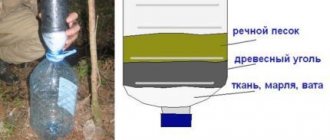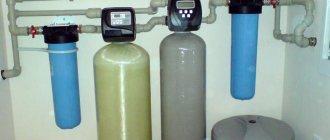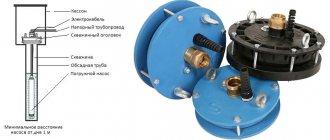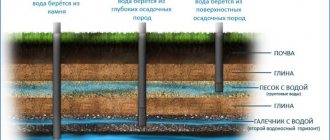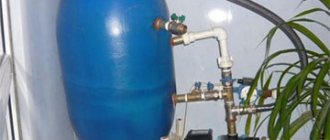According to scientists involved in studying the ecological state of the Earth, pollution of the soil and atmosphere today, alas, has already become something of a norm. It is difficult to find a territory on the planet where everything would be fine. Even if they are far from industrial centers, pollution is transferred over vast distances, and you can’t vouch for anything.
DIY water filter
Various chemicals spread with wind, precipitation and, of course, end up in water bodies and groundwater. In this regard, purification, if water is planned to be used for food purposes, is an extremely important issue. To do this, it is recommended to use high-quality filter units, preferably permanently located. But sometimes circumstances develop in such a way that cleaning is required in conditions where an industrial filter is not available for one reason or another. What should I do? It turns out that you can sometimes make a water filter with your own hands at home or even on a camping trip, without incurring any special costs.
Why do you need to purify water?
Water from open sources is characterized by the following physical and chemical indicators:
- Taste - sour, salty, sweet, bitter. It comes from dissolved impurities and gases.
- Smell: hydrogen sulfide, swampy, putrid, fishy, muddy, etc. Its source is substances found in wastewater or that enter the liquid naturally.
- Turbidity and color come from organic components, particles of clay and silt, and microorganisms.
To make a simple homemade filter, you can use an Aquaphor cartridge. The price of such a filter is about 400 rubles, for this price you can filter about 200 liters of water.
In addition, water that has not passed through at least a simple water filter contains industrial and domestic wastewater, combustion products of various types of fuel, harmful chemical elements, particles of dolomite, lime, gypsum, and sand.
The Aquaphor filter is great for hiking and traveling.
With this filter you can filter river or rain water. To be safe, boil the water before use. All this can cause:
- gastrointestinal diseases;
- intoxication of the body;
- the accumulation of salts in it, which lead to diseases of the joints, bladder, the formation of gall and kidney stones, allergic reactions, and the development of iron bacteria.
In these cases, water purification, even with homemade filters, sharply reduces the likelihood of negative consequences for humans.
Overview of filtration materials
Water purification is carried out through porous layers of materials that can be replaced as needed or in connection with the assigned tasks. To determine the quality level of filtration, water must be sent for laboratory analysis. Sometimes it is enough to visually feel the difference between the original and purified water in terms of taste characteristics.
The main list of filtration materials is traditional: cotton wool, gauze, cotton fabrics, pebbles, coal. But sometimes the question arises, what to prefer and why?
River or quartz sand
For the purpose of mechanical purification of water from impurities and contaminants, sand is used. Quartz is considered the most suitable due to the suitable shape of its grains and mineral purity. The angularity of the particles resists sticking, a property important for filtration. Quartz sand is finely dispersed, which enhances the quality of water purification.
Charcoal or coconut shell
The use of coal is associated with the removal of pesticides, traces of chlorine, ozone, and organic matter through the adsorption process. Efficiency is achieved provided the structure is porous.
If the charcoal was produced in a factory method, then technology ensures that the charcoal has pores. Making coal yourself does not lead to the desired stage, although there will still be some porosity.
The best cleansing structure of charcoal is achieved by charring coconut shells or pits of plums, apricots or peaches.
Lutrasil
An additional filter component that has recently appeared on the modern market. The presence of special polypropylene fibers in it ensures high-quality cleaning from impurities and substances harmful to humans.
How to choose filter media
This water filtration is the most basic, and as we know: “Everything ingenious is simple!”
To filter out solid particles suspended in liquids, salts, excess iron, and also to adsorb odors, different materials are used as fillers for filter elements:
- Cotton wool, linen cloth, or cotton are suitable for collecting a fabric filter for water purification.
- You can make a charcoal version of the cleaning device - use a product that is produced for cooking kebabs.
- For short-lived appliances, use paper napkins. They are good at removing suspended matter that cannot dissolve.
- A high-quality sorbent is a natural mineral of volcanic origin - zeolite. It absorbs unpleasant odors, mold, and toxins.
- After washing and disinfection in the oven or on fire, gravel, quartz sand or stones of medium and fine fractions are used to filter the water.
- Mechanical cleaning can be organized using lutrasil, a non-woven polypropylene fabric that is common in agriculture.
- At the molecular level, silver has a disinfecting effect. You can use any suitable items made of this metal.
Subtleties of work
You can understand the principle of water purification by reverse osmosis only by understanding what the direct purification method is. Imagine a membrane with certain substances on one side and water masses on the other. And so, the liquid will pass through the barrier and be diluted with the solution until the osmotic pressure, under the influence of which the movement of water molecules occurs, is equal to the hydrostatic one. With reverse osmosis technology, everything happens the other way around. By means of hydrostatic injection, substances pass through the pores, penetrating into the aqueous composition. In this case, the membrane gasket acts as a filter, trapping all organisms and impurities.
Activated carbon device for dirty water purification
Coal will help remove contaminants of organic and inorganic origin, as well as ozonate and eliminate water chlorination products.
As a filler in a homemade carbon-based filter, a product washed with alkalis or acids (activated) or regenerated is used.
If you purchase coal with a silver coating, you will get a product that has bactericidal properties. Without such treatment, microorganisms and bacteria are able to penetrate the filter device.
Used coal can be restored 3-4 times as follows:
- rinse with running water 2-3 times, placing it in an enamel bowl;
- Let it sit for 2-3 hours;
- dissolve soda (3% bicarbonate) in 3 liters of water and pour the composition over the regenerated product;
- Boil the mixture for half an hour;
- strain after draining and rinsing.
When manufacturing a cleaning system, you need to consider:
- water pressure;
- liquid temperature (boiling water cannot be filtered);
- absence of nearby heating sources, which can lead to loss of sorbent properties.
Activated carbon is characterized by a porous structure, due to which purification occurs. Both powder and granular materials are suitable for this.
The quality of the resulting water depends on the thickness of the layer. The speed of passage of liquid through the filter is selected so as to ensure the required contact time between the liquid and the carbon for cleaning. 100 g of product can reliably neutralize 200 ml of water in 1 minute.
Small-sized camping varieties
A small filter for purifying water from toxic substances and mineral formations, which you can take with you when going outdoors, hunting or fishing, is easy to make. The product will remove the effects of microorganisms, rid the liquid of unpleasant odor and taste, and make the drink transparent.
It is important to choose the right mineral structure. A good level of cleaning in a portable device will be provided by medium-sized granules - large ones will let contaminants through, and small particles of powder will seep into the liquid.
Make a hole in the cigar case and fill it with filter elements.
We fill the case like this: two cm of cotton wool at the very bottom, then an eight cm layer of ground activated carbon, then a 2 cm layer of cotton wool. All layers are clamped with a plate of water-permeable porous plastic, which is used in industrial water filters. For homemade devices, it is better to take coal from birch and other deciduous trees. Needles can give water a specific smell. It’s easy to prepare the material yourself. You need to heat pieces of wood red-hot in a stove or over a fire in a metal container and cool them.
If the need for filtration arose unexpectedly, then the coals and ash left over from the fire are suitable as a filler. Combustion products are loaded into a plastic bottle or any other suitable container and liquid is passed through them.
Making a carbon water purifier
The carbon water filter can be assembled in a more suitable housing.
To do this you need to prepare:
- A cartridge whose base is made from several food containers or plastic bottles.
- A suitable tool is a screwdriver or awl, a knife, scissors.
- The filler is charcoal, prepared independently or purchased in advance.
- Granulates that can further improve the quality of drinking liquid are gravel and quartz sand.
- Plugs or covers made of plastic.
- Gauze, bandage or cloth to perform initial rough cleaning of large debris.
Use electrical tape or silicone glue to strengthen the joints of the device. For ease of use, a homemade device can be suspended by threading a cord or wire through holes made in a plastic bottle with the bottom cut off. A cap that can be unscrewed a few turns to allow water to flow is suitable as a tap.
To facilitate subsequent replacement of the filler, a fabric cover is often used. Then the filter layers are laid. Gravel and pebbles are placed last. First - coal and sand. You can place cotton wool at the neck as a fine filter.
The main disadvantage of such systems is the slow filtration process.
Useful homemade PVC pipe
Homemade filters for water purification, which can compete with industrially produced products, can be made for a country house or cottage. If the water supply is supplied from a lake, pond, river, a well is drilled or a shaft well is made, the installation of filtering devices is necessary.
Cleaning devices are made using improvised means. Will need:
- 2 containers;
- part of the water pipe made of plastic - 50-80 cm;
- plastic bottle caps;
- cotton wool;
- filler;
- tools.
The procedure for making a water filter from PVC pipe.
- A cover is glued into the PVC pipe, in which several holes are made. It will act as a mesh backing when laying cotton wool and gauze as the primary layers of the filter.
- Place a layer of padding polyester and lay another cover without glue.
- The neck, cut off from the bottle, is attached to the pipe with the thread facing outward. Wrap with electrical tape.
- A lid with a fabric gasket is attached to the other end.
- The pipe is filled with activated carbon.
- The segments are connected using threads and plastic bottles are placed on both sides.
Myths
Among users of filtering systems there are always skeptics who claim that water after cleaning becomes tasteless, unhealthy, and even wastewater pollutes the environment. Let's try to dispel such guesses.
Reverse osmosis flushes out the minerals our bodies need.
The liquid that comes into our tap contains many useful mineral inclusions, however, the percentage of them is so small that it cannot have any effect on our health. But the content of heavy particles indigestible by the body is quite impressive. For those who want to receive more micro and macroelements, it is better to consider a balanced diet.
A large number of drains
To wash the membrane, some of the water is actually used, which makes it possible to replace the expensive component several times a year and keep the system clean. Sewage is discharged into the sewer system, but is quite purified and can be used for irrigation and other domestic needs.
Nobody needs pre-filters
The main filter element is sensitive to high contents of chlorine, iron and organics, so mechanical cleaning leads to a reduction in the volume of these products to acceptable levels, ensuring the correct operation and durability of the purifier.
This H2O is absolutely tasteless, lifeless
There is no clear confirmation of this statement. When a person drinks liquid from the tap for several years, he gets used to its taste. In comparison with chlorinated tap water or sweetish iron-containing water, it really can be considered “empty”. It also does not have the metallic aftertaste associated with well water. However, many note the similarity with thawed milk, which is the standard of quality. This effect is achieved by using a carbon filter.
Filtered composition spoils teeth
The membrane, along with various impurities, also separates fluoride, which is necessary to strengthen tooth enamel. Will the lack of calcium gradually lead to tooth decay? In theory yes, but in practice no. For more than 30 years, scientists have been conducting research in this area and not a single patient has yet developed problems with the oral cavity while consuming distilled H2O.
Too expensive a purchase
If we talk about the initial installation of the system, the cost will be around 20,000 rubles. Further, it is necessary to change the filter elements twice a year, post-filters and the membrane unit - once a season. The price for consumables will be about 5,000 rubles. It turns out to be a decent amount, which makes you think about the need to purchase. However, calculate the amount of consumption per year (minimum 2 liters per day and 700 liters) and it turns out that a liter costs about 50-60 kopecks. It is unlikely that you will find a bottled version in the store for that kind of money. Plus, you will be confident in the quality of the product purified by our own system.
Main table dispenser AquaPro 919H/RO (hot and cold water)
Main table dispenser AquaPro 929CH/RO (cooling/heating)
Floor dispenser AquaPro 311 (empty, without cooling)
Water filter for aquarium
A flow device for purifying water in aquariums can be made independently at home.
The body can be constructed from 2 syringes or take a plastic tube of the desired diameter. To secure the device to the wall, you will need a suction cup. Device assembly:
- Remove the moving part from the syringes and put them away. Cut off the spouts of the remaining parts and connect the tubes to each other with hot glue.
- Using a soldering iron or a heated nail, make holes on the surface of one of the syringes.
- Place zeolite and spray inside the product.
Preparation and installation
First you need to purchase barrels, for example, plastic or wooden. The barrel should be located directly under the drainpipe. It should be located a short distance from the building and it is recommended to place either bricks or stones under it.
Next, we install a faucet, which we will later use to drain filtered water. We install a solid partition in the barrel and make small holes, then covering them with a membrane that allows water to pass through. Next, let's get to the fun part!
Sand option for the pool
Before you make a water filter with your own hands, you need to decide on the volume of liquid that needs to be cleaned. If the displacement is small, then home-made devices with sand filling are suitable.
Any container of suitable size can perform the functions of a cartridge. Liquid supply and outlet pipes are inserted into it and sand or other filler is placed. A PVC corner is useful for turning the pipe.
For efficient cleaning, several containers can be connected together using an M10 threaded sleeve. A compressor is connected to the system, the power of which is calculated depending on the volume of the pool.
Is H20 purified in this way useful?
Having figured out how a reverse osmosis installation works, the opinions of experts were divided into two points of view: some argue that the purer the liquid, the better for all organs; others - that the composition should contain a maximum of natural microelements, which are removed by filtration. The first opinion is based on a number of facts:
- Pure water does not contain components that will accumulate in the body;
- the composition without impurities does not cause allergies;
- thanks to the extractable properties, food prepared on this basis is healthy and tasty;
- Not all minerals found in natural sources are needed by your body. Their content in liquid is negligible, and we get the bulk of the elements from food.
Homemade water filter
The water filter is made independently from 3 containers arranged in series. It will only function under pressure.
A 1/4-inch adapter nipple is suitable for connecting glass or plastic containers together. When assembling, you must follow the guides indicated on the parts.
Seal the joints of the product with synthetics. You can use Teflon tape for carving.
The filter elements are connected to the water supply system in series through a tee. Activated carbon is used as a filler.
Advantages
- The quality of the water obtained at the output - it can be used as drinking water, used for cooking, given to children and animals. It is much healthier than boiled one.
- Despite the complexity of the system, it is quite compact, and the only visible parts are a convenient faucet on the sink.
- Manufacturers form a kit of all components, including tools and fasteners, ensuring ease of installation.
- All station parts are replaceable. Despite the initial high cost of the set, further expenses will be solely on replacing filters.
- Many installations are equipped with monitoring sensors and signal the need to replace components.
Manual well cleaning
To clean it manually, you must either go down into the well yourself and pump out the water, or use the help of a professional.
The basic cleaning tools you will need are warm clothing, rubber boots, a safety rope, a flashlight, a bucket, rags, a sponge and even a brush for cleaning concrete or surfaces of the mine to clean its walls during the process of descending to a depth while simultaneously pumping out water. You will also need washed crushed stone of fraction 40*30, which will need to be added to the bottom of the well after cleaning its bottom.
Cleaning the bottom is the most basic and difficult thing
If the water in the well does not come from a perfectly clean spring, then a protective bottom filter is placed at its bottom.
In many ways, the quality of well water depends on a well-made bottom filter.
The most valuable materials for a bottom filter are quartz sand, natural crushed stone, gravel, shungite, bath stone (jadeite), geotextiles, which are laid in several layers. At the very bottom there is also a bottom shield, which is designed to protect the bottom filter from destruction by groundwater.
One of the options for cleaning the bottom is to completely remove it, clean it and put all the bottom filter materials back in place.
The second method is even simpler and more realistic - to remove the bottom dirt from the top layer of crushed stone and add 15-20 cm of fresh washed crushed stone of the same standard fraction (40*30).
Sealing seams and gaps between rings in a well shaft
Experts recommend using a special solution based on sand, liquid glass and cement for these purposes. There is also a special composition called hydroseal, which can be used if finances allow.
Disinfection (disinfection)
Disinfection involves treating the walls with a solution of ten percent chlorinated lime, which is also poured onto the bottom of the well. For two days, you must prevent the well from filling with water and, if there is any, you must pump it out immediately.
As a result, bleaching (a chlorinated solution) and cleaning the mine will allow the well water to regain its natural properties.
Homemade liqueur recipes
Today, recipes for homemade liqueurs, as before, are very popular. Liqueur is an alcoholic drink that consists of alcoholized juices of fruits or berries. Often in the process of its preparation, infusions of fragrant herbs and various spices are used. The strength of the drink usually varies from 15 to 45%, and it tastes quite sweet because a lot of sugar is added to it.
Recipes for homemade liqueurs are, in fact, quite simple. The first recipe involves making banana liqueur. To do this you will need the following ingredients:
- 2 bananas
- 500 ml alcohol,
- 1 sachet saffron (small)
- 1 packet of vanillin,
- 1 liter of water.
Peel the bananas, cut into slices, place in a glass bottle and fill with alcohol. Wrap the container in newspaper so that light does not fall on it, and remove it for 14 days. Next, you need to prepare the syrup. To do this, bring water to a boil, dissolve sugar, vanillin and saffron in it. Wait until the syrup has cooled, add it to the strained alcohol, stir and pour into bottles.
Many people will be interested in learning recipes for chocolate liqueur.
- 1.5 liters of vodka,
- 1 kg sugar,
- 200 gr. dark chocolate,
- 2 glasses of milk,
- 2 glasses of water,
- 2 gr. vanilla sugar.
Keep the chocolate in the freezer for a few minutes, then grate it using a medium grater. Place the resulting shavings in a glass container, or a jar, fill with vodka and add vanilla sugar. Mix the mixture thoroughly, cover and leave for a week at room temperature. For a richer taste of the liqueur, it is recommended to shake the contents of the jar daily.
After a week, add sugar syrup to the mixture. How to make it? To do this, pour milk into the pan and add sugar. The resulting mass should be mixed and heated over low heat and boiled for about 7 minutes. Then remove the pan from the heat and cool. Pour the cooled syrup into the chocolate mass, close the jar with a lid and put the liqueur in a cool place for another 5 weeks. Strain the finished liqueur and pour into bottles.
There are also various liqueur recipes for coffee lovers. For instant coffee based liqueur you will need:
- 500 ml vodka,
- 1 cup of iced coffee,
- 450 gr. Sahara.
Sugar is added to cold coffee, stirred, and heated over low heat. Having brought the coffee mass to a boil, it must immediately be removed from the heat and cooled. Pour in the required amount of vodka and stir. Pour the thick drink into any glass container, close it and put it in a cool place for a week. During the period of infusion of the liqueur, do not forget to shake the container with the contents several times a day.
Thus, by studying the above recipes, you can prepare not only interesting liqueurs and liqueurs, but also delicious liqueurs that are suitable both for the festive table and for preparing unusual alcoholic cocktails.
